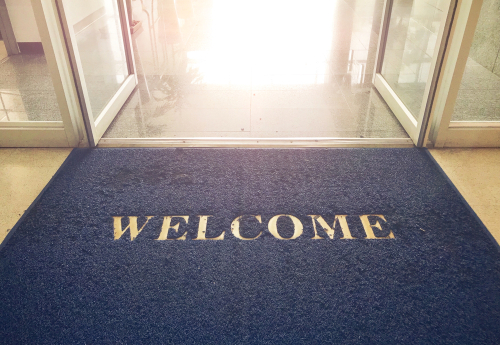Entrance floor mats are crucial in helping to keep facilities clean, safe, and healthy throughout the year. And with colder, wetter, and icier weather right around the corner, their value is more important now than ever.
Because of this, all building owners and facility managers should know how important floor mats are. While there are many reasons for installing mats at building entries, we’ve narrowed our scope to what we believe are the three most important reasons.

These are the following:
1. Floor Mats Stop Contaminants in Their Tracks
Most of the soil entering a facility is walked in through the front door, as soils, moisture, and pollutants adhere to shoe bottoms. With foot traffic, these contaminants can transfer—get redeposited—onto hard- and soft-surface floors.
To show you how bad this can be, a study was conducted by Dr. Charles Gerba, a microbiologist at the University of Arizona. For this study, Gerba had 10 people wear brand-new shoes for two weeks. The shoes were then sampled for bacteria. He found that the outsides of the shoes, including the shoe bottoms, averaged 421,000 units of bacteria.
That’s a massive number of bacteria collected in just two weeks, but it’s not the end of the story.
Gerba then sought to determine how much bacteria are transferred to floors as people walk into facilities. What he uncovered was that the transfer rate was an astonishing 90% to 99%.
The installation of effective floor mats is among the best ways to prevent this from happening.
2. Floor Mats Help Reduce Cleaning Needs and Costs
Along with enormous amounts of bacteria, we also mentioned that all kinds of soil can collect on shoes. With foot traffic, these contaminants can be redeposited onto floors inside facilities. When this happens, cleaning professionals must spend much more time cleaning and maintaining these floors.
For instance, these soils can eat away at floor finish. The result is that floors must be scrubbed more often to remove the soils. After that, a thin layer of floor finish must be reapplied to help protect the floors.
Floor soiling can also increase refinishing cycles, where the floors must be completely stripped of floor finish and several new coats of floor finish must be applied. Once again, the installation of floor mats can keep these costs down.
And let’s not forget soft-surface floors. These same soils can collect on carpet, resulting in spotting and staining of the carpet. Removing spots and stains can increase carpet cleaning frequencies, both of which are time-consuming and expensive. Further, while most spots can be removed from carpet, this is not necessarily true of stains.
The big difference between spots and stains is that spots can be removed, but stains tend to be permanent. When stains happen, very often about the only option is to remove—i.e., cut out—the problem area.
3. Floor Mats Help Green Facilities
Most all building owners and facility managers are very focused on keeping their facilities healthier. One way they are accomplishing this is by using environmentally preferable cleaning tools, solutions, and cleaning methods.
The installation of floor mats also plays a role in keeping facilities healthy, as they can capture and trap many of the discussed contaminants long before they enter a facility. This can help reduce cleaning needs, which means fewer cleaning solutions may be necessary.
Whenever we can reduce the amount of cleaning solution used in a facility, green or traditional, it helps reduce cleaning’s impact on the environment, which is the goal of green cleaning.
Length Matters
Hopefully, we have pointed out just how important floor mats are and three of the most important benefits they can provide. However, we also need to discuss something just as important: floor mat length. Sufficient length helps ensure the optimum performance of floor mats.
Too short, and floor mats will not be able to do their job, which is capturing and trapping contaminants and preventing them from being walked into a facility. Too long, and they are no longer cost-effective. So, let’s look a bit closer at this “lengthy” issue.
Floor Mats and Footsteps
On a rainy, wintery day, we’re all pretty good about wiping our shoes on floor mats before walking into our homes. Many of us go a step further and remove our shoes entirely.
But this is not necessarily the case when we walk into a public facility like a school, office, shopping center, or medical facility. Therefore, building owners and managers must install mats long enough to do this wiping and shoe bottom cleaning for us.
So how long is enough? Studies indicate it takes a minimum of six footsteps on a mat before it can remove moisture and contaminants from shoe bottoms. For the mat to accomplish this, it should be at least 10 feet long; in some cases, 12 to even 20 feet may be necessary.
Floor Mats and Footstep Volume
Let’s see if we can narrow this down a bit and help you determine the right length of mats specifically for your facility. The first thing we need to know is that, according to ISSA, the worldwide cleaning association, entrance matting of at least six feet can capture and trap 40% of the soil from being walked onto floors. This ability to capture and trap soils jumps considerably if 12 to 15 feet are installed.
With this in mind, we must also consider something known as “footstep volume,” more commonly referred to as foot traffic. If 80 or fewer people walk into your facility from the same entry per day, that is considered “low” footstep volume. Floor mats that are six to 10 feet long should do the job.
If, however, 400 people enter the facility from the same entrance per day, we are now talking about medium to high footstep volume. Matting as long as 15 feet should be installed. For more than 400 people per day, at least 20 feet of matting is recommended.
By the way, if someone enters your facility in a wheelchair, we need to bear in mind that it takes about 10 feet of matting to thoroughly clean a complete revolution of the wheelchair and ensure most of the moisture and soil on the wheels are removed.
Entry Mat Selection
As beneficial as floor mats are, facility managers must realize that selecting the right entry floor mats for your facility can be a bit complicated. For instance, did you know three types of entry mats may be necessary? These three are the following:
- Scraper mats placed outside a facility to remove larger debris from shoe bottoms;
- Wiper/scrapers installed next to remove larger debris from shoe bottoms as well as more minor soils and moisture; and
- Wiper mats installed directly inside facilities—in building lobbies, for instance. Their job is to remove any remaining soils and moisture from shoe bottoms.
Some mat manufacturers make all three; others do not. Some mat manufacturers say all three are needed; others say they are not.
Work with a knowledgeable janitorial distributor to make the product selection easier and more specific for your facility.
These people are very aware of these issues and the specific needs of your facility. They help prevent “trial and error” purchasing, which can be a significant cost saving as well.

Michael Wilson is AFFLINK’s Vice President of Marketing and Packaging. He has been with the organization since 2005 and provides strategic leadership for the entire supply chain team. In his free time, Michael enjoys working with the Wounded Warrior Project, fishing, and improving his cooking skills. He can be reached through his company website at www.AFFLINK.com.
